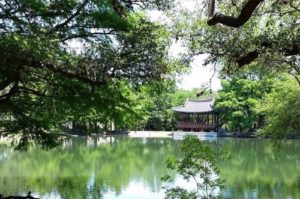Apparently that sugar story, and my dad’s reaction to it, created a real antipathy in me towards this issue. I’m just having the hardest time ever reading it. I may break down and go forward to January 2016 soon and just read this one whenever I can bring myself to do so.
Additionally, I’m sort of experiencing a reading detour at the moment. For several years during my childhood, my dad bought me one Nancy Drew mystery book a month. I’ve been planning to read them for the last, oh, ten years or so, and in this last week or so, I’ve begun that project. I’m now up to #14, The Whispering Statue. They’re pretty dated, of course. Nancy wastes a lot of gas driving to places where she can make phone calls and things of that nature. One detail that I didn’t remember from my childhood stuck out at me — several of these books make an attempt at multiculturalism. For example, we meet a Native American woman in The Secret of Shadow Ranch and The Mystery of the Ivory Charm features several characters from India. The child character, Rishi, has trouble with the first person singular pronoun that’s kind of distressing for me. It’s established that Rishi speaks Hindi, and Hindi does, in fact, have a first person singular pronoun.
Anyway, on to the lions of the August 2013 issue of National Geographic:
The Short Happy Life of a Serengeti Lion, by David Quammen, photographs by Michael Nichols
I’m somewhat confounded by this title. The article is about the social structure of lion prides and their assorted coalitions of males. We follow one two-member coalition of males, C-Boy and Hildur, as they mate with the females in their prides and fight off invaders, most notably a four-male coalition that are referred to as the Killers.
Lion prides are only females, generally grandmothers, mothers, sisters, and aunts. Males work in small groups that affiliate with the prides and father their children. When a new coalition of males moves in, they kill off or drive away the cubs, which causes the females of cub-bearing age to go back into estrus and then the new males father new cubs on the females.
In this article, we find that the biggest cause of death for lions is other lions. Males will, of course, kill the offspring of other males, and males will kill other adult males. Males will occasionally kill females (and it is from this that The Killers got their names — they are the prime suspects in the deaths of several females that were being studied).
Overall, this does not sound like a happy life to me. But then again, I’m not a lion (at least, I would expect that someone would have told me if I were . . . ) so maybe that is happiness for a lion.
Living with Lions, by David Quammen, photographs by Brent Stirton
Living with Lions leads off with a picture of a man with no arms being bathed by another man. This led me to believe that this was going to be another article like the one on leopards moving into cities from December 2015. It isn’t. The meat of this article is about lion conservation.
The home range of the lion has shrunk over the past millennia. According to Quammen, at one point, lions spread at least as far north as France, as evidenced by the lions in the cave drawings in Chauvet Cave. And now the lion is confined to Africa and even that habitat is shrinking. Lions do come into conflict with humans, but things like the human population expanding into the territory of the lions and trophy hunting are causing a lot of the drop in population.
We also meet a group called the Lion Guardians. They are members of the Maasai tribe, who traditionally have hunted lions, to protect the lions instead. They are paid a salary and trained in how to track lions with radio collars and they track the lions and prevent lions from killing livestock. As of 2013, the program appeared to be working, and lion killings were on the downswing.


